利用者:Ebeshi 1212/sandbox
 |
ここはEbeshi 1212さんの利用者サンドボックスです。編集を試したり下書きを置いておいたりするための場所であり、百科事典の記事ではありません。ただし、公開の場ですので、許諾されていない文章の転載はご遠慮ください。
登録利用者は自分用の利用者サンドボックスを作成できます(サンドボックスを作成する、解説)。 その他のサンドボックス: 共用サンドボックス | モジュールサンドボックス 記事がある程度できあがったら、編集方針を確認して、新規ページを作成しましょう。 |
本稿は、量子力学について専門的でない入門書です。より詳しい記事については、量子力学のカテゴリを参照してください。
量子力学の序論
[編集]量子力学とは原子や素粒子のスケールで、物質とそのエネルギーとの相互作用を研究する学問である。 一方、古典物理学における物質やエネルギーは、月などの天体の動きなど人間が経験する身近なスケールでのみ説明される。古典物理学は、今でも現代の科学技術の多くで使われている。 しかし、19世紀末になると、大きな世界(マクロ)と小さな世界(ミクロ)の両方で、古典物理学では説明のつかない現象が発見された。[1] 観測された現象と古典物理学との間の矛盾を解決したいという研究欲求は、物理におけるパラダイムシフトをもたらし、相対性理論と量子力学の発展が起きた。[2] 本稿では、20世紀初頭、物理学者たちが古典物理学の限界を発見し、それに取って代わる量子論の主要概念をどのように構築していったかを紹介する。 本稿では、これらの概念を発見された順に解説している。より詳細な歴史については、「量子力学の歴史」を参照。
光は、ある面では粒子のように振る舞い、ある面では波のように振る舞う。電子や原子などの粒子からなる宇宙の物質も、波動的な振る舞いをする。 ネオンのような光源は、特定の周波数の光しか発しないものがあり、ネオンの原子構造によって決まる小さな純色の集合体である。 量子力学では、光は他のあらゆる電磁波と同様、光子と呼ばれる離散的な単位でやってくることを示し、その分光エネルギー(純色に相当)と光線の強さを予測することができる。1個の光子は、電磁場の量子(観測可能な最小の粒子)である。 部分光子は、実験的に観測されることはない。さらに言えば、位置、速度、角運動量など、古典力学の拡大図では連続的に見えていた物体の性質が、量子力学の拡大図では非常に小さく、量子化されていることがわかる。 このような素粒子の性質は、小さな離散的な許容値の集合のいずれかを取ることが求められ、これらの値の間のギャップも小さいため、非常に小さな(原子ほどの)スケールでしか不連続性が現れないのである。
量子力学の多くの側面は、直感に反し、[3] 逆説的に見えることがある。それは、より大きなスケールで見た場合とは全く異なる挙動を記述しているからだ。 量子物理学者リチャード・P・ファインマンの言葉を借りれば、量子力学は「ありのままの不条理な自然」を扱っている。[4] 一つのパラドックスは、ニュートンの法則と量子力学の間にある矛盾のことで、量子力学から得られる平均値(例えば位置や運動量)は古典法則に従うことを示すエーレンフェストの定理を用いて説明することができる。[5] しかし、エーレンフェストの定理は、これまで観測されてきた反直観的な現象(量子のおかしさ)をすべて説明できるわけではなく、対応する原理の数学的表現に過ぎなかった。
例えば、量子力学の不確定性原理は、ある測定(粒子の位置など)を厳密に行えば行うほど、同じ粒子に関する別の補完的な測定(速度など)の精度が低くなることを意味している。
他の例として、上下に偏光した光など、2値の粒子の状態を測定すると、その後に測定したもう一方の粒子の状態が、常に2値のうちのいずれか一方(例えば、反対方向に偏光した光)になる「もつれ」である。
最後の例は超流動で、絶対零度近くまで冷やされた容器内の液体ヘリウムが、重力に逆らって容器の開口部を上下に(ゆっくりと)流れていく現象がある。
最初の量子論:マックス・プランクと黒体放射
[編集]
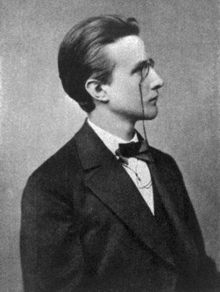
熱放射とは、物体の内部エネルギーにより、その表面から放射される電磁波のことである。物体が十分に加熱されると、赤熱するため、スペクトルの赤色の端にある光を放出し始める。

さらに加熱すると、赤から黄、白、青へと色が変化し、波長が短く(周波数が高く)なるにつれて発光するようになる。完全放射体とは、完全吸収体でもある。 これは、降り注ぐ光をすべて吸収し、何も発しないからである。 したがって、理想的な熱放射体は黒体と呼ばれ、それが発する放射は黒体放射と呼ばれる。
19世紀後半には、熱放射は実験的にかなりよく特徴づけられていた。しかし、古典物理学では、図に示すように、低周波では実験結果とよく一致するが、高周波では強く不一致するレイリー・ジーンズの法則が導出された。 物理学者たちは、すべての実験結果を説明する単一の理論を探し求めた。
熱放射の全スペクトルを説明できる最初のモデルは、1900年にマックス・プランクが提唱したものである。[6] 彼は、熱放射が一組の調和振動子と平衡状態にある数学的モデルを提案した。実験結果を再現するためには、各発振器が任意の量のエネルギーを放出できるのではなく、単一の特性周波数で整数の単位のエネルギーを放出すると仮定する必要があった。 つまり、発振器が発するエネルギーが量子化されていたのだ。[脚注 1] プランクによると、各発振器のエネルギー量は、発振器の周波数に比例し、その比例定数は、現在プランク定数として知られている。 プランク定数は、通常hと書かれ、次のような値を持っている: 6.63×10−34 J s 。
つまり、周波数fの発振器のエネルギーEは次式のようになる。
このような放射体の色を変えるには、その温度を変化させる必要がある。温度を上げると、より多くのエネルギーが放出されるようになり、そのエネルギーのうち、紫色のスペクトルがより多くなることを意味する。
プランクの法則は、物理学における最初の量子論であり、プランクは1918年に「エネルギー量子の発見によって物理学の進歩に貢献したこと」を認められ、ノーベル賞を受賞した。[8]しかし、当時プランクは、量子化は単なるヒューリスティクスな数学的構成であり、むしろ(現在考えられているように)世界に対する我々の物理への理解を根本的に変えるものだと考えていた。[9]
光子:光の量子化
[編集]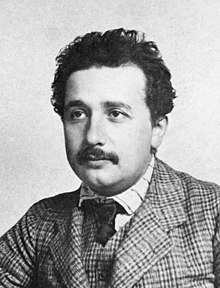
1905年、アルベルト・アインシュタインがさらに一歩踏み込んだ。アインシュタインは、量子化とは単なる数学的構成ではなく、光線のエネルギーは実際には個々のパケット(現在では光子と呼ばれている)で発生することを示唆したのである。光子のエネルギーEは、周波数fの光のエネルギーに、その周波数にプランク定数 h (極めて小さな正の数)を掛けたものである。
光は波なのか、それとも小さな粒子の流れなのかという疑問があったが、 19世紀には、観測された屈折、回折、干渉、偏光などの効果を説明できるようになり、波動説に軍配が上がったと一般に考えられている。[10] マクスウェルは、電気、磁気、光がすべて同じ現象、すなわち電磁場の現れであることを示した。マクスウェルの方程式は、古典電磁気学の完全な法則であり、光を波として記述している、つまり振動する電場と磁場の組み合わせである。 波動説を支持する証拠が圧倒的に多いため、アインシュタインの考えは、当初はとても懐疑的な目で見られた。
しかし、最終的には、光子モデルが支持されるようになった。光電効果に見られるいくつかの不可解な性質を説明できるようになったことが、このモデルを支持する最も重要な根拠の一つである(次のセクションで説明する)。しかし、回折、屈折、干渉など、光の他の性質を理解する上で、波のアナロジーは不可欠なものであることに変わりはなかった。
光電効果
[編集]
1887年、ハインリヒ・ヘルツは、十分な周波数の光が金属表面に当たると、その表面から電子が放出されることを観測した。[11] 1902年には、フィリップ・レーナルトが、放出される電子の最大可能エネルギーが、光の強度ではなく、周波数に関係していることを発見した。周波数が低すぎると、強度に関係なく電子が放出されない。 赤い端に向かう強い光は電位を全く発生させないかもしれないし、紫の端に向かう弱い光はどんどん高い電圧を発生させるかもしれない。電子を放出させることができる光の最低周波数は、閾値と呼ばれ、金属によって異なっている。 この観測は、電子のエネルギーが入射光の強さに比例するはずだと予測する古典電磁気学とは相反するものである。[12] そのため、物理学者が光電効果を示すデバイスを発見した当初は、光の強度が高ければ、高い電圧が光電素子から発生すると予想された。
アインシュタインは、光線は粒子(光子)の流れであり、光線の周波数がfであれば、各光子はhfに等しいエネルギーを持っていると仮定して、この効果を説明した。[11] 電子に当たる光子は1個だけで、電子に与えるエネルギーはせいぜいhfである。[11] したがって、光線の強度は影響せず、 その周波数のみが電子に付与できる最大エネルギーを決定する。[11]
アインシュタインは、閾値の効果を説明するために、金属から電子を取り出すには、仕事関数と呼ばれるφで示されるある一定のエネルギーが必要だと主張した。[11] このエネルギー量は、金属ごとに異なる。 光子のエネルギーが仕事関数より小さい場合、光子は金属から電子を取り除くのに十分なエネルギーを持たない。 閾値周波数 f0はエネルギーが仕事関数に等しい光子の周波数である。
fが f0,より大きい場合、 エネルギー は電子を追い出すのに十分である。放出された電子の運動エネルギー EK,は、最大でも光子のエネルギーから電子を金属から離脱させるのに必要なエネルギーを差し引いたものに等しい。つまり、
が成り立つ。
アインシュタインは、光は粒子で構成されていると説明し、プランクの量子化エネルギーの概念を拡張した。ある周波数の1個の光子は、不変のエネルギー量を供給するというものである。つまり、個々の光子は、その周波数に依存して、より多くのエネルギーを供給することも、より少ないエネルギーを供給することもできる。自然界では、単一光子と出会うことはほとんどない。太陽や19世紀に利用可能な発光源は、1秒間に膨大な数の光子を放出するため、1個1個の光子が運ぶエネルギーの重要性は明白ではなかった。 アインシュタインは、光の個々の単位に含まれるエネルギーは周波数に依存するという考えを示したことで、それまで直感に反していると思われていた実験結果を説明することが可能になった。しかし、光子は粒子であるにもかかわらず、周波数という波動的な性質を持つものとして説明されていた。つまり、光は粒子であるという説明では不十分であり、波動性が必要なのであった。[13]
光が量子化されることによる影響
[編集]電磁波の周波数と光子のエネルギーの関係から、紫外線は日焼けの原因になり、可視光線や赤外線はその原因にならない。紫外線は1光子あたりのエネルギーが大きく、日焼けのような細胞障害を引き起こすのに十分なエネルギーがある。一方、赤外線はエネルギーが弱く、肌を温める程度である。ゆえに、赤外線ランプは広い面を暖めることができ、寒い部屋でも快適に過ごすことができるかもしれない。[14]
同じ周波数の光子はすべて同じエネルギーを持ち、異なる周波数の光子はすべて比例して(次数1, Ephoton = hf ) 異なるエネルギーを持つ。[15] しかし、光子によって与えられるエネルギーはどの周波数でも不変であるが、光を吸収する前の光電素子内の電子の初期エネルギー状態は必ずしも一様ではない。個々の電子の場合、異常な結果が生じることがある。例えば、光電素子の平衡準位以上に励起されていた電子が特徴的な低周波の光を吸収すると、放出されることがある。しかし、統計的に見ると、光電素子の特性は、大多数の電子が平衡準位にあるときの振る舞いを反映している。このことは、量子力学における小さな個体の研究と、古典物理学における大きな個体の研究との違いを明確にするのに役立つ。[要出典]
物質の量子化:ボーア原子の模型
[編集]20世紀の初めには、正電荷を帯びた小さな原子核を、負電荷を帯びた電子の雲が取り囲んでいるという原子のモデルが、証拠として導出されていた。このような性質から、電子は星の周りを回る惑星のように原子核の周りを回っているというモデルが考えられた。 しかし、このモデルでは原子が不安定になることもわかっていた。古典的な理論によれば、軌道を回る電子は求心加速度を受けているため、電磁波を放射するはずだが、そのエネルギーが失われることによって電子は螺旋状に原子核に向かって進み、一瞬にして原子核と衝突してしまうのである。
もう1つは、原子の発光スペクトルの謎である。気体を加熱すると、不連続な周波数の光だけが放出される。例えば、水素が放つ可視光は、下の図のように4つの色で構成されている。また、周波数が異なると光の強さも異なる。一方、白色光は、可視光線の周波数全域で連続的に発光している。19世紀末には、バルマーの公式と呼ばれる簡単な規則が、異なる線の周波数の関係を示したが、その理由は説明されず、強度についての予測もなされていなかった。また、この公式は、当時観測されていなかった紫外光と赤外光のスペクトル線を追加で予測した。これらの線は、後に実験的に観測され、この公式の価値に対する信頼が高まった。
In 1885 the Swiss mathematician Johann Balmer discovered that each wavelength λ (lambda) in the visible spectrum of hydrogen is related to some integer n by the equation
where B is a constant Balmer determined is equal to 364.56 nm.
In 1888 Johannes Rydberg generalized and greatly increased the explanatory utility of Balmer's formula. He predicted that λ is related to two integers n and m according to what is now known as the Rydberg formula:[16]
where R is the Rydberg constant, equal to 0.0110 nm−1, and n must be greater than m.
Rydberg's formula accounts for the four visible wavelengths of hydrogen by setting m = 2 and n = 3, 4, 5, 6. It also predicts additional wavelengths in the emission spectrum: for m = 1 and for n > 1, the emission spectrum should contain certain ultraviolet wavelengths, and for m = 3 and n > 3, it should also contain certain infrared wavelengths. Experimental observation of these wavelengths came two decades later: in 1908 Louis Paschen found some of the predicted infrared wavelengths, and in 1914 Theodore Lyman found some of the predicted ultraviolet wavelengths.[16]
Both Balmer and Rydberg's formulas involve integers: in modern terms, they imply that some property of the atom is quantized. Understanding exactly what this property was, and why it was quantized, was a major part of the development of quantum mechanics, as shown in the rest of this article.
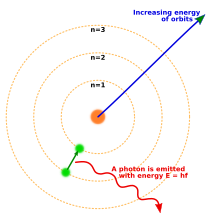
1913年、ニールス・ボーアは、電子の軌道を量子化した新しい原子のモデルを提案した。電子は、惑星が太陽の周りを回るように原子核の周りを回るが、特定の軌道にしか乗ることが許されず、任意の距離を周回することはできない。[17] 原子がエネルギーを放出(吸収)するとき、電子は原子核の周りのある軌道から別の軌道へと、古典的に予想されるような連続的な軌道を描いて移動することはない。電子は、ある軌道から別の軌道へと瞬時に移動し、光子として放出されるのである。[18] 各元素が放つ光子のエネルギーは、軌道のエネルギー差によって決まるので、各元素の発光スペクトルにはいくつもの線が含まれることになる。[19]
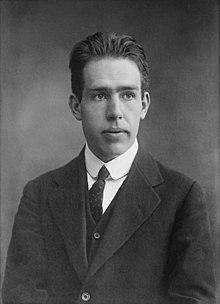
軌道が従うべき規則についてのたった一つの単純な仮定から出発したボーア模型は、観測された水素の発光スペクトルのスペクトル線を、それまで知られていた定数と関連づけることができたのである。ボーアのモデルでは、電子はエネルギーを放出し続けて原子核に衝突することは許されず、いったん許される最も近い軌道に乗れば、永久に安定する。ただ、ボーアのモデルでは、なぜ軌道がそのように量子化されなければならないのか、複数の電子を持つ原子を正確に予測することはできなかったし、あるスペクトル線が他のスペクトル線より明るい理由も説明することができなかった。
しかし、発光スペクトルの不連続線は、原子の電子が持つ何らかの性質が量子化されたものであるという重要な結果は正しい。しかし、電子が実際にどのように振る舞うかは、ボーアの原子とも、私たちが日常的に体験している世界とも大きく異なっている。このような現代の原子の量子力学モデルについては、後述する。
Bohr theorized that the angular momentum, L, of an electron is quantized:
where n is an integer and h and ħ are the Planck constant and Planck reduced constant respectively. Starting from this assumption, Coulomb's law and the equations of circular motion show that an electron with n units of angular momentum orbits a proton at a distance r given by
- ,
where ke is the Coulomb constant, m is the mass of an electron, and e is the charge on an electron. For simplicity this is written as
where a0, called the Bohr radius, is equal to 0.0529 nm. The Bohr radius is the radius of the smallest allowed orbit.
The energy of the electron[note 1] can also be calculated, and is given by
- .
Thus Bohr's assumption that angular momentum is quantized means that an electron can inhabit only certain orbits around the nucleus and that it can have only certain energies. A consequence of these constraints is that the electron does not crash into the nucleus: it cannot continuously emit energy, and it cannot come closer to the nucleus than a0 (the Bohr radius).
An electron loses energy by jumping instantaneously from its original orbit to a lower orbit; the extra energy is emitted in the form of a photon. Conversely, an electron that absorbs a photon gains energy, hence it jumps to an orbit that is farther from the nucleus.
Each photon from glowing atomic hydrogen is due to an electron moving from a higher orbit, with radius rn, to a lower orbit, rm. The energy Eγ of this photon is the difference in the energies En and Em of the electron:
Since Planck's equation shows that the photon's energy is related to its wavelength by Eγ = hc/λ, the wavelengths of light that can be emitted are given by
This equation has the same form as the Rydberg formula, and predicts that the constant R should be given by
Therefore, the Bohr model of the atom can predict the emission spectrum of hydrogen in terms of fundamental constants.[note 2] However, it was not able to make accurate predictions for multi-electron atoms, or to explain why some spectral lines are brighter than others.
波と粒子の二重性
[編集]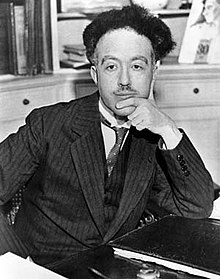
光に波動性と粒子性の両方があるように、物質にも波動性がある。[20]
電子光線は、光や水の波と同じように回折を起こすことができる。 その後、原子や分子でも同様の波動的な現象が示されるようになった。
物体の波長λは、プランク定数hを介して、その運動量pに関係する。ゆえに次式が成り立つ。[21][22]
ド・ブロイの仮説と呼ばれるこの関係は、すべての物質が粒子と波の両方の性質を持つというもので、あらゆる種類の物質について成立している。
波動と粒子の二重性とは、古典的な「粒子」の概念でも「波」の概念でも、量子スケールの物体である光子や物質の振る舞いを完全に記述することはできない、という概念である。波動と粒子の二重性は、量子力学における相補性の原理の一例である。[23][24][25][26][27] 波動と粒子の二重性のすっきりとわかりやすい例である二重スリット実験については、次のセクションで説明する。
二重スリット実験
[編集]
1803年にヤングが、[28] その10年後にフレネルが行った二重スリット実験では[28] 狭い間隔で並んだ2つのスリットに光線を通すと、スクリーン上に明暗の干渉模様が現れる。片方のスリットを塞げば、干渉による縞の強さはどこでも半分になると思うかもしれない。実は、もっと単純な、開いたスリットの正反対の回折パターンが見られるのである。水の波でも同じような振る舞いが見られるので、二重スリットの実験は、光の波動性を示すものと見なされていた。
二重スリットの実験は、電子や原子、大きな分子でも同じような干渉パターンが見られる。[29][30] このように、すべての物質は粒子と波の両方の性質を持っていることが証明されている。
光度を下げて、光子や電子などの粒子を1つだけ通過させても、時間とともに同じ干渉パターンが発生する。量子粒子は、二重スリットを通過するときは波として振る舞い、検出されるときは粒子として振る舞う。これは、量子粒子が波としての性質を測定する実験では波のように振る舞い、粒子としての性質を測定する実験では粒子のように振る舞うという、量子相補性の典型的な特徴である。検出器の画面上で個々の粒子が現れる点は、ランダムな過程による結果である。しかし、多数の個々の粒子の分布パターンは、波が作り出す回折パターンに似ている。
ボーア模型への応用
[編集]ド・ブロイは、原子核の周りを回る電子が波のような性質を持っていると考えられることを示し、ボーアの原子模型を拡張した。特に、電子が観測されるのは、原子核のまわりに定常波が発生するような状況である。定常波の例として、両端が固定され振動させることができるバイオリンの弦がある。弦楽器が作る波は、その場で振動しているように見え、山から谷へ上下に移動する。定在波の波長は、振動する物体の長さと境界条件に関係する。 例えば、バイオリンの弦は両端が固定されているため、次式のように波長の定在波を伝えることができる: 。ここで、lは長さ、nは正の整数である。 ド・ブロイは、電子の軌道が許されるのは、軌道の周長が波長の整数倍となる軌道であるとした。つまり、電子の波長によって、原子核からある距離のボーア軌道だけが可能であることが決定される。つまり、原子核からの距離がある値より小さいと、軌道を作ることができない。この原子核からの最小距離をボーア半径という。[31]
シュレーディンガーが量子論的事象を記述する波動方程式を考えようとしたとき、ド・ブロイの量子事象の取り扱いが出発点となった。
スピン
[編集]1922年、オットー・シュテルンとヴァルター・ゲルラッハは、銀原子を不均質な磁場の中に射出した。古典力学では、磁場を通過した磁石は、そのN極を中心に、上や下、あるいはその中間を向いて、上や下に大きく偏向することがある。シュテルンとゲルラッハが磁場の中に放り込んだ原子も、同じような働きをした。しかし、磁石の偏向距離はさまざまだが、原子は常に上下どちらかに一定に偏向している。これは、磁石の向きに対応する原子の性質が、どの角度からも自由に選べるのではなく、上か下かの2値で、量子化されていることを意味している。
ラルフ・クローニッヒは、原子や電子などの粒子は、ある軸を中心に回転しているように振る舞うという理論を提唱した。スピンがあれば、磁気モーメントの消失が説明でき、同じ軌道にある2つの電子が反対方向に「スピン」すれば、異なる量子状態を占め、排他律が満たされることになる。量子数は、スピンの意味(正または負)を表していた。
シュテルン・ゲルラッハ実験で使用する磁場の向きは任意に選択できる。ここで紹介するアニメーションでは、磁場は垂直なので、原子は上か下に偏向される。磁石を1/4回転させると、原子は左右どちらかに偏向する。垂直磁場では縦軸のスピンが量子化され、水平磁場では横軸のスピンが量子化されることがわかる。
シュテルン・ゲルラッハ装置から出た原子のビームを、検出器のスクリーンに当てる代わりに、同じ方向を向いた別の(不均一な)磁場に通すと、すべての原子がこの第2の磁場で同じように偏向される。しかし、2番目の磁場が1番目の磁場に対して90°の向きにある場合、原子の半分は一方に、半分はもう一方に偏向され、原子の水平軸と垂直軸に関するスピンは互いに独立となる。しかし、これらのビームの1つ(例えば、上に偏向してから左に偏向した原子)を、最初の磁場と同じ向きの3番目の磁場に通すと、元々はすべて同じ方向に向かっていたにもかかわらず、原子の半分が一方に、もう半分が他方に向かう。水平磁場での原子のスピンを測定することで、垂直磁場での原子のスピンが変化している。
シュテルン・ゲルラッハ実験は、量子力学のいくつかの重要な特徴を示している:
- 自然界のある特徴は、量子化されており、ある離散的な値しかとれないことが証明されている。
- 粒子は、古典的に回転する物体の角運動量とよく似た固有の角運動量を持っている。
- 量子力学では、測定によって測定対象が変化する。ある物体のスピンは、ある方向にのみ知ることができ、別の方向のスピンを観測すると、スピンに関する元の情報が破壊される。
- 量子力学は確率論であり、装置に送り込まれた個々の原子のスピンが正であるか負であるかはランダムである。
現代量子力学の発展
[編集]1925年、ヴェルナー・ハイゼンベルクは、ボーアの原子模型が解決できなかった問題のひとつ、水素の輝線スペクトルの強度を説明することに挑戦した。彼は、数学的な類推を重ね、古典的な強度の計算の量子力学的な類推を書き出した。[32] その後まもなく、ハイゼンベルクの同僚であるボルンは、異なるエネルギー準位間の遷移の確率を計算するハイゼンベルクの方法が、行列という数学的概念を用いることによって最もよく表現できることに気づいた。
同年、ド・ブロイの仮説を基に、エルヴィン・シュレーディンガーが量子力学的な波の振る舞いを記述する方程式を開発した。[33] この数学モデルは、生みの親の名をとって「シュレーディンガー方程式」と呼ばれ、量子力学の中心的存在である。量子系に許される定常状態を定義し、物理系の量子状態が時間的にどう変化するかを記述するものである。[34] 波そのものは、「波動関数」と呼ばれる数学的関数で記述される。シュレーディンガーは、波動関数が「測定結果の確率を予測するための手段」を提供すると言った。[35]
シュレーディンガーは、水素原子の電子を古典的な波として扱い、陽子がつくる電位の中を移動することで、水素のエネルギー準位を計算することができたのだ。この計算により、ボーア模型のエネルギー準位が正確に再現された。
1926年5月、シュレーディンガーは、ハイゼンベルクの行列力学と自分の波動力学が、電子の性質や振る舞いについて同じ予測をしていること、数学的にこの2つの理論には共通する形式があることを証明した。しかし、二人は互いの理論の解釈について意見の相違があった。例えば、ハイゼンベルクは、原子の軌道間の電子のジャンプの理論的予測を受け入れたが、[36] シュレーディンガーは、連続した波のような性質に基づく理論が、彼の言う「量子ジャンプに関するこのナンセンス」を回避できると期待した(ヴィルヘルム・ヴィーンの言い換えによる)。[37] 最終的には、ハイゼンベルクのアプローチが勝利し、量子ジャンプが確認された。[38]
コペンハーゲン解釈
[編集]
ボーアやハイゼンベルクらは、これらの実験結果や数学モデルが本当に意味するところを説明しようとした。量子力学のコペンハーゲン解釈と呼ばれる彼らの説明は、測定によって探求され、量子力学の数学的定式化によって記述される現実の本質を記述することを目的としていた。
コペンハーゲン解釈の主な原則は次のとおりである:
- このシステムは、通常ギリシャ文字で表される波動関数 によって完全に記述される (ハイゼンベルク)
- どのように が時間とともに変化するかはシュレーディンガー方程式によって与えられる。[要説明]
- 自然界の記述は、基本的に確率論的である。ある事象の確率、例えば二重スリットの実験で粒子が画面上のどこに現れるかは、その波動関数の振幅の絶対値の二乗に関係する。(マックス・ボルンによるボルン則。確率振幅はコペンハーゲン解釈における波動関数に物理的な意味を与えるものである。)
- このシステムのすべての特性の値を同時に知ることは不可能であり、正確にわからない特性は確率で記述する必要がある。(ハイゼンベルクの不確定性原理)
- 物質は、エネルギーと同じように、波動と粒子の二重性を持っている。実験では、物質の粒子的性質と波動的性質のどちらかを示すことができるが、両方を同時に示すことはできない。(ボーアによる相補性の原理)。
- 測定器は基本的に古典的な装置であり、位置や運動量といった古典的な性質を測定するものである。
- マクロな量子力学的記述は、古典的記述に近似する必要がある。(ボーアとハイゼンベルグの対応原理)。
これらの原則がもたらす様々な結果については、以下のセクションで詳述する。
不確定性原理
[編集]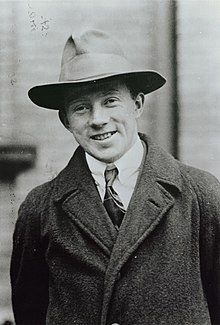
ある物体の位置と速度を測定したいとする。例えば、レーダーによるスピードトラップを通過する車である。このとき、車の位置と速度は一定であることが前提である。これらの値をどれだけ正確に測定できるかは、測定器の品質に依存する。測定器の精度が上がれば、より真値に近い結果が得られる。このように、車の速度と位置は、操作上、いくらでも正確に定義して同時に測定することができると考えられる。
1927年、ハイゼンベルクは、この最後の仮定が正しくないことを証明した。[39] 量子力学は、例えば位置と速度のようなある対の物理特性は、任意の精度で同時に測定したり、操作用語として定義したりすることができないことを示している。つまり、一方の特性をより正確に測定したり、操作用語として定義したりするほど、もう一方の精度は低くなる。これは不確定性原理と呼ばれるものである。この不確定性原理は、単に測定器の精度を示すだけでなく、より深く、測定された量の概念的な性質を示すものである。車や人のスケールでは、これらの不確実性は無視できるものだが、原子や電子を扱うときには致命的なものになるのだった。[40]
ハイゼンベルグは、光の光子を用いて電子の位置と運動量を測定することを例として挙げた。電子の位置を測定する場合、光子の周波数が高いほど、光子が電子に衝突する位置は正確に測定できるが、電子の乱れは大きくなる。これは、電子が光子の衝突によってランダムなエネルギーを吸収し、その運動量(運動量は速度に質量をかけたもの)の測定値が不確かになるためで、元の運動量(位置と同時に測定すべき運動量)ではなく、衝突生成物による衝突後の乱れた運動量を測定しなければならない。より低い周波数の光子では、運動量の乱れ(したがって不確定性)は小さくなるが、衝突位置の測定の精度も下がる。[41]
不確定性原理の核心は、位置と速度の領域でどのような数学的解析を行っても、位置領域でより鋭い(より正確な)曲線を得るには、速度領域でより緩やかな(より正確でない)曲線を犠牲にするしかないという事実であり、その逆もまた然りである。位置領域でより正確にするには、速度領域でより多くの周波数が寄与してより細いカーブを描く必要があり、その逆もまた然りである。これは、関連する測定や補完的な測定に固有の基本的なトレードオフだが、素粒子サイズに近い最小(プランク)スケールでこそとても顕著に現れる。
不確定性原理は、粒子の位置と運動量(運動量は速度と質量の掛け算)の不確かさの積がある値より小さくなることはありえないこと、そしてこの値がプランク定数関連していることを数学的に示すものである。
波動関数の崩壊
[編集]波動関数の崩壊とは、測定によって量子的な(確率的または潜在的な)状態が強制的に、あるいは明確な測定値に変換されたことを意味する。この現象は、古典力学ではなく、量子力学でのみ見られる。
例えば、ある光子が実際に検出画面に「現れる」までは、それがどこに現れるかという確率でしか説明できない。例えば、電子カメラのCCDに光子が現れた場合、その光子が電子機器と相互作用した時間と空間は非常に限られた範囲内でしか知ることができない。しかし、光子は捕獲(測定)される過程で消滅し、その量子の波動関数も一緒に消滅してしまう。例えば、写真フィルムの露光点であるCCDのセル内の電位変化などである。
固有状態と固有値
[編集]不確定性原理のため、粒子の位置や運動量に関する記述は、位置や運動量が何らかの数値を持っている確率しか与えることができない。したがって、確率雲の中の電子のような不確定なものの状態と、明確な値を持つものの状態との違いを明確に定式化することが必要である。ある物体がある点で確実に「固定」できるとき、その物体は「固有状態」を持っているという。
先ほどのシュテルン・ゲルラッハの実験では、原子の縦軸周りのスピンは、上と下の2つの固有状態を持つ。測定する前は、どの原子も等しい確率でスピンアップまたはスピンダウンが見つかるとしか言いようがない。測定によって、波動関数は2つの状態のいずれかに崩壊する。
縦軸のスピンの固有状態は、同時に横軸のスピンの固有状態ではないので、この原子は横軸のスピンのどちらかの値を持つことが等しい確率で見つかる。上のセクションで説明したように、水平軸に関するスピンを測定することで、スピンアップした原子がスピンダウンすることができる。水平軸に関するスピンを測定すると、その波動関数がこの測定の固有状態の1つに縮退し、それはもはや垂直軸に関するスピンの固有状態ではないので、どちらの値も取ることができる。
パウリの排他原理
[編集]
1924年、パウリは、観測された分子スペクトルと量子力学の予測との間の矛盾を解決するために、2つの値をとりうる新しい量子自由度(量子数)を提案した。水素原子のスペクトルには、本来1本の線があるはずのところに、わずかな差で2本の線がある「ダブレット」と呼ばれる現象があることがわかった。パウリは、「原子の中にある2つの電子が同じ量子数を持つような量子状態の原子は存在し得ない」という排他原理を打ち立てた。[42]
その1年後、ウーレンベックとガウズミットは、パウリの新しい量子数をスピンと呼ばれる性質と同定し、その効果がシュテルン・ゲルラッハ実験で観測されたのである。
水素原子への応用
[編集]ボーアの原子模型は、基本的に惑星のようなもので、電子は原子核の「太陽」のまわりを回っている。しかし、不確定性原理により、電子は惑星のように正確な位置と速度を同時に持つことはできない。そこで、電子は古典的な軌道の代わりに、原子の軌道を回っていると言われている。軌道とは、電子が存在する可能性のある場所の「雲」のことで、正確な場所というよりは、確率の分布のようなものである。[42] 各軌道は2次元ではなく3次元であり、電子が95%の確率で見つかる3次元の領域として描かれることが多い。[43]
シュレーディンガーは、水素原子の電子を、陽子がつくる電位の井戸Vの中にある波動関数Ψで表される波として扱うことで、水素のエネルギー準位を計算することができるようになった。シュレーディンガー方程式の解は、電子の位置と場所に対する確率の分布である。軌道は3次元的にさまざまな形をしている。異なる軌道のエネルギーが計算でき、ボーア模型のエネルギー準位と正確に一致する。
シュレーディンガーの図の中では、それぞれの電子は4つの性質を持っている:
- 粒子波が原子核に近くてエネルギーが少ないものか、原子核から遠くてエネルギーが多いものかを示す「軌道」の指定。
- 軌道の「形」、球形かそれ以外か。
- 軌道の「傾き」で、z軸周りの軌道の磁気モーメントを決定する。
- 電子の「スピン」。
これらの性質を総称して、「電子の量子状態」と呼ぶ。量子状態は、これらの性質にそれぞれ数字を与えることで記述することができ、これを電子の量子数と呼ぶ。電子の量子状態は、波動関数によって記述される。パウリの排他律により、原子内の2つの電子が4つの数すべてを同じ値で持つことはない。

軌道を記述する最初の性質は、ボーアの原子模型と同じ主量子数nであり、nは各軌道のエネルギー準位を示す。nの取りうる値は整数である。
次の量子数である方位量子数(l)は、軌道の形状を表すものである。この形状は、軌道の角運動量に起因しています。角運動量とは、回転している物体が外力によって速くなったり遅くなったりするときの抵抗力を表している。方位量子数は、電子が原子核の周りを回るときの軌道角運動量を表している。lは0からn - 1までの整数(nは電子の主量子数)である。
各軌道の形状は、通常、方位量子数ではなく、文字で表記される。最初の形状(l=0)は文字sで示される(由来は「sphere(球体)」)。次の形はpで示され、ダンベルのような形をしている。他の軌道はもっと複雑な形をしており(原子軌道を参照)、d, f, g などの文字で表される。
第3の量子数である磁気量子数は、電子の磁気モーメントを表すもので、ml(または単にm)で表される。mlの値は-lからlまでの整数である(lは電子の方位量子数)。
磁気量子数は、角運動量の特定方向の成分を測定するものである。方向は任意であるが、従来はz方向が選ばれていた。
4番目の量子数であるスピン量子数(電子のスピンの「向き」に関係する)はmsと表記され、値は+1⁄2または-1⁄2である。
化学者のライナス・ポーリングは、例としてこう書いている。
In the case of a helium atom with two electrons in the 1s orbital, the Pauli Exclusion Principle requires that the two electrons differ in the value of one quantum number. Their values of n, l, and ml are the same. Accordingly they must differ in the value of ms, which can have the value of +1⁄2 for one electron and −1⁄2 for the other."[42]
周期表の構成は、原子軌道の基本的な構造と対称性、および電子の軌道への充填の仕方によって決定される。異なる原子の原子軌道が結合して分子軌道を形成する方法は、原子間の化学結合の構造と強さを決定する。
Dirac wave equation
[編集]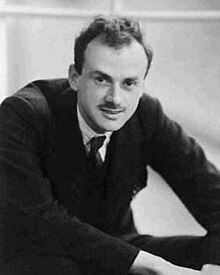
In 1928, Paul Dirac extended the Pauli equation, which described spinning electrons, to account for special relativity. The result was a theory that dealt properly with events, such as the speed at which an electron orbits the nucleus, occurring at a substantial fraction of the speed of light. By using the simplest electromagnetic interaction, Dirac was able to predict the value of the magnetic moment associated with the electron's spin and found the experimentally observed value, which was too large to be that of a spinning charged sphere governed by classical physics. He was able to solve for the spectral lines of the hydrogen atom and to reproduce from physical first principles Sommerfeld's successful formula for the fine structure of the hydrogen spectrum.
Dirac's equations sometimes yielded a negative value for energy, for which he proposed a novel solution: he posited the existence of an antielectron and a dynamical vacuum. This led to the many-particle quantum field theory.
Quantum entanglement
[編集]
The Pauli exclusion principle says that two electrons in one system cannot be in the same state. Nature leaves open the possibility, however, that two electrons can have both states "superimposed" over each of them. Recall that the wave functions that emerge simultaneously from the double slits arrive at the detection screen in a state of superposition. Nothing is certain until the superimposed waveforms "collapse". At that instant, an electron shows up somewhere in accordance with the probability that is the square of the absolute value of the sum of the complex-valued amplitudes of the two superimposed waveforms. The situation there is already very abstract. A concrete way of thinking about entangled photons, photons in which two contrary states are superimposed on each of them in the same event, is as follows:
Imagine that we have two color-coded states of photons: one state labeled blue and another state labeled red. Let the superposition of the red and the blue state appear (in imagination) as a purple state. We consider a case in which two photons are produced as the result of one single atomic event. Perhaps they are produced by the excitation of a crystal that characteristically absorbs a photon of a certain frequency and emits two photons of half the original frequency. In this case, the photons are interconnected via their shared origin in a single atomic event. This setup results in superimposed states of the photons. So the two photons come out purple. If the experimenter now performs some experiment that determines whether one of the photons is either blue or red, then that experiment changes the photon involved from one having a superposition of blue and red characteristics to a photon that has only one of those characteristics. The problem that Einstein had with such an imagined situation was that if one of these photons had been kept bouncing between mirrors in a laboratory on earth, and the other one had traveled halfway to the nearest star when its twin was made to reveal itself as either blue or red, that meant that the distant photon now had to lose its purple status too. So whenever it might be investigated after its twin had been measured, it would necessarily show up in the opposite state to whatever its twin had revealed.
In trying to show that quantum mechanics was not a complete theory, Einstein started with the theory's prediction that two or more particles that have interacted in the past can appear strongly correlated when their various properties are later measured. He sought to explain this seeming interaction classically, through their common past, and preferably not by some "spooky action at a distance". The argument is worked out in a famous paper, Einstein, Podolsky, and Rosen (1935; abbreviated EPR) setting out what is now called the EPR paradox. Assuming what is now usually called local realism, EPR attempted to show from quantum theory that a particle has both position and momentum simultaneously, while according to the Copenhagen interpretation, only one of those two properties actually exists and only at the moment that it is being measured. EPR concluded that quantum theory is incomplete in that it refuses to consider physical properties that objectively exist in nature. (Einstein, Podolsky, & Rosen 1935 is currently Einstein's most cited publication in physics journals.) In the same year, Erwin Schrödinger used the word "entanglement" and declared: "I would not call that one but rather the characteristic trait of quantum mechanics."[44] Ever since Irish physicist John Stewart Bell theoretically and experimentally disproved the "hidden variables" theory of Einstein, Podolsky, and Rosen, most physicists have accepted entanglement as a real phenomenon.[45] However, there is some minority dispute.[46] The Bell inequalities are the most powerful challenge to Einstein's claims.
Quantum field theory
[編集]The idea of quantum field theory began in the late 1920s with British physicist Paul Dirac, when he attempted to quantize the energy of the electromagnetic field; just like in quantum mechanics the energy of an electron in the hydrogen atom was quantized. Quantization is a procedure for constructing a quantum theory starting from a classical theory.
Merriam-Webster defines a field in physics as "a region or space in which a given effect (such as magnetism) exists".[47] Other effects that manifest themselves as fields are gravitation and static electricity.[48] In 2008, physicist Richard Hammond wrote:
Sometimes we distinguish between quantum mechanics (QM) and quantum field theory (QFT). QM refers to a system in which the number of particles is fixed, and the fields (such as the electromechanical field) are continuous classical entities. QFT ... goes a step further and allows for the creation and annihilation of particles ...
He added, however, that quantum mechanics is often used to refer to "the entire notion of quantum view".[49]:108
In 1931, Dirac proposed the existence of particles that later became known as antimatter.[50] Dirac shared the Nobel Prize in Physics for 1933 with Schrödinger "for the discovery of new productive forms of atomic theory".[51]
On its face, quantum field theory allows infinite numbers of particles and leaves it up to the theory itself to predict how many and with which probabilities or numbers they should exist. When developed further, the theory often contradicts observation, so that its creation and annihilation operators can be empirically tied down.[要説明] Furthermore, empirical conservation laws such as that of mass–energy suggest certain constraints on the mathematical form of the theory, which are mathematically speaking finicky. The latter fact makes quantum field theories difficult to handle, but has also led to further restrictions on admissible forms of the theory; the complications are mentioned below under the rubric of renormalization.
Quantum electrodynamics
[編集]Quantum electrodynamics (QED) is the name of the quantum theory of the electromagnetic force. Understanding QED begins with understanding electromagnetism. Electromagnetism can be called "electrodynamics" because it is a dynamic interaction between electrical and magnetic forces. Electromagnetism begins with the electric charge.
Electric charges are the sources of and create, electric fields. An electric field is a field that exerts a force on any particles that carry electric charges, at any point in space. This includes the electron, proton, and even quarks, among others. As a force is exerted, electric charges move, a current flows, and a magnetic field is produced. The changing magnetic field, in turn, causes electric current (often moving electrons). The physical description of interacting charged particles, electrical currents, electrical fields, and magnetic fields is called electromagnetism.
In 1928 Paul Dirac produced a relativistic quantum theory of electromagnetism. This was the progenitor to modern quantum electrodynamics, in that it had essential ingredients of the modern theory. However, the problem of unsolvable infinities developed in this relativistic quantum theory. Years later, renormalization largely solved this problem. Initially viewed as a provisional, suspect procedure by some of its originators, renormalization eventually was embraced as an important and self-consistent tool in QED and other fields of physics. Also, in the late 1940s Feynman's diagrams depicted all possible interactions on a given event. The diagrams showed in particular that the electromagnetic force is the exchange of photons between interacting particles.[52]
The Lamb shift is an example of a quantum electrodynamics prediction that has been experimentally verified. It is an effect whereby the quantum nature of the electromagnetic field makes the energy levels in an atom or ion deviate slightly from what they would otherwise be. As a result, spectral lines may shift or split.
Similarly, within a freely propagating electromagnetic wave, the current can also be just an abstract displacement current, instead of involving charge carriers. In QED, its full description makes essential use of short-lived virtual particles. There, QED again validates an earlier, rather mysterious concept.
Standard Model
[編集]In the 1960s physicists realized that QED broke down at extremely high energies.[要出典] From this inconsistency the Standard Model of particle physics was discovered, which remedied the higher energy breakdown in theory. It is another extended quantum field theory that unifies the electromagnetic and weak interactions into one theory. This is called the electroweak theory.
Additionally, the Standard Model contains[要出典] a high energy unification of the electroweak theory with the strong force, described by quantum chromodynamics. It also postulates a connection with gravity as yet another gauge theory, but the connection is as of 2015 still poorly understood. The theory's successful prediction of the Higgs particle to explain inertial mass was confirmed by the Large Hadron Collider,[53] and thus the Standard model is now considered the basic and more or less complete description of particle physics as we know it.
Interpretations
[編集]The physical measurements, equations, and predictions pertinent to quantum mechanics are all consistent and hold a very high level of confirmation. However, the question of what these abstract models say about the underlying nature of the real world has received competing answers. These interpretations are widely varying and sometimes somewhat abstract. For instance, the Copenhagen interpretation states that before a measurement, statements about a particle's properties are completely meaningless, while in the Many-worlds interpretation describes the existence of a multiverse made up of every possible universe.[54]
Applications
[編集]Applications of quantum mechanics include the laser, the transistor, the electron microscope, and magnetic resonance imaging. A special class of quantum mechanical applications is related to macroscopic quantum phenomena such as superfluid helium and superconductors. The study of semiconductors led to the invention of the diode and the transistor, which are indispensable for modern electronics.
In even the simple light switch, quantum tunneling is absolutely vital, as otherwise the electrons in the electric current could not penetrate the potential barrier made up of a layer of oxide. Flash memory chips found in USB drives also use quantum tunneling, to erase their memory cells.[55]
See also
[編集]- Einstein's thought experiments
- Macroscopic quantum phenomena
- Philosophy of physics
- Quantum computing
- Virtual particle
- List of textbooks on classical and quantum mechanics
Notes
[編集]- ^ In this case, the energy of the electron is the sum of its kinetic and potential energies. The electron has kinetic energy by virtue of its actual motion around the nucleus, and potential energy because of its electromagnetic interaction with the nucleus.
- ^ The model can be easily modified to account for the emission spectrum of any system consisting of a nucleus and a single electron (that is, ions such as He+ or O7+, which contain only one electron) but cannot be extended to an atom with two electrons such as neutral helium.
References
[編集]- ^ “Quantum Mechanics”. National Public Radio. 22 June 2016閲覧。
- ^ Kuhn, Thomas S. The Structure of Scientific Revolutions. Fourth ed. Chicago; London: The University of Chicago Press, 2012. Print.
- ^ “Introduction to Quantum Mechanics”. Socratease. 2017年9月15日時点のオリジナルよりアーカイブ。 Template:Cite webの呼び出しエラー:引数 accessdate は必須です。
- ^ Feynman, Richard P. (1988). QED : the strange theory of light and matter (1st Princeton pbk., seventh printing with corrections. ed.). Princeton, NJ: Princeton University Press. pp. 10. ISBN 978-0691024172
- ^ “Remarks concerning the status & some ramifications of EHRENFEST'S THEOREM”. 2021年7月10日時点のオリジナルよりアーカイブ。 Template:Cite webの呼び出しエラー:引数 accessdate は必須です。
- ^ This result was published (in German) as Planck, Max (1901). “Ueber das Gesetz der Energieverteilung im Normalspectrum”. Ann. Phys. 309 (3): 553–63. Bibcode: 1901AnP...309..553P. doi:10.1002/andp.19013090310.. English translation: “On the Law of Distribution of Energy in the Normal Spectrum”. 18 April 2008時点のオリジナルよりアーカイブ。 Template:Cite webの呼び出しエラー:引数 accessdate は必須です。
- ^ Francis Weston Sears (1958). Mechanics, Wave Motion, and Heat. Addison-Wesley. p. 537
- ^ “The Nobel Prize in Physics 1918”. Nobel Foundation. 2009年8月1日閲覧。
- ^ Kragh, Helge (1 December 2000). “Max Planck: the reluctant revolutionary”. PhysicsWorld.com. Template:Cite webの呼び出しエラー:引数 accessdate は必須です。
- ^ “Revival of the Wave Theory of Light in the Early Nineteenth-Century”. www.encyclopedia.com. 16 October 2018閲覧。
- ^ a b c d e Taylor, J. R.; Zafiratos, C. D.; Dubson, M. A. (2004). Modern Physics for Scientists and Engineers. Prentice Hall. pp. 127–29. ISBN 0135897890
- ^ Hawking, Stephen (November 6, 2001) (英語). The Universe in a Nutshell. 55. Impey, C.D.. Bantam Spectra (April 2002発行). p. 80~. doi:10.1063/1.1480788. ISBN 978-0553802023. オリジナルのSeptember 21, 2020時点におけるアーカイブ。 December 14, 2020閲覧。 Alt URL
- ^ Dicke, Robert Henry; Wittke, James P. (1960). Introduction to Quantum Mechanics. Addison-Wesley Publishing Company. p. 12. ISBN 978-0201015102
- ^ Jim Lucas: 'What Is Ultraviolet Light?', 15 September 2017, at livescience.com Accessed 27 December 2017
- ^ 'Two Equations Governing Light's Behavior: Part Two E = hν' at chemteam.info Accessed 27 December 2017
- ^ a b Taylor, J. R.; Zafiratos, C. D.; Dubson, M. A. (2004). Modern Physics for Scientists and Engineers. Prentice Hall. pp. 147–48. ISBN 0135897890
- ^ McEvoy, J. P.; Zarate, O. (2004). Introducing Quantum Theory. Totem Books. pp. 70–89, [89]. ISBN 1840465778
- ^ World Book.Inc (2007). “22” (英語). World Book Encyclopedia (Electronic reproduction). The World Book encyclopedia. 22 (3 ed.). Chicago, Illinois: World Book. p. 6. ISBN 978-0716601074. OCLC 894799866. オリジナルの30 January 2017時点におけるアーカイブ。 December 14, 2020閲覧。 Alt URL
- ^ Wittke, J.P; Dicke, R.H (June 1, 1961). “11”. In Holladay, W.G. (英語). Introduction to Quantum Mechanics (eBook). 16. Nashville, Tennessee: ADDISON WESLEY LONGMAN INC. January 1, 1978. p. 10. doi:10.1063/1.3057610. ISBN 978-0201015102. OCLC 53473 December 14, 2020閲覧。
- ^ McEvoy, J. P.; Zarate, O. (2004). Introducing Quantum Theory. Totem Books. pp. 110ff. ISBN 1840465778
- ^ Aczel, Amir D., Entanglement, pp. 51ff. (Penguin, 2003) ISBN 978-1551926476
- ^ McEvoy, J. P.; Zarate, O. (2004). Introducing Quantum Theory. Totem Books. p. 114. ISBN 1840465778
- ^ Zettili, Nouredine (2009). Quantum Mechanics: Concepts and Applications. John Wiley and Sons. pp. 26–27. ISBN 978-0470026786
- ^ Selleri, Franco (2012). Wave-Particle Duality. Springer Science and Business Media. pp. 41. ISBN 978-1461533320
- ^ Podgorsak, Ervin B. (2013). Compendium to Radiation Physics for Medical Physicists. Springer Science and Business Media. pp. 88. ISBN 978-3642201868
- ^ Halliday, David; Resnick, Robert (2013). Fundamentals of Physics, 10th Ed.. John Wiley and Sons. pp. 1272. ISBN 978-1118230619
- ^ Myers, Rusty L. (2006). The Basics of Physics. Greenwood Publishing Group. pp. 172. ISBN 0313328579. "complementarity principle wave-particle duality."
- ^ a b Shamos, Morris H (1 January 1987). Great Experiments in Physics: Firsthand Accounts from Galileo to Einstein. Courier Corporation. p. 108
- ^ Merali, Zeeya (21 May 2015). “Quantum physics: What is really real?”. Nature 521 (7552): 278–80. Bibcode: 2015Natur.521..278M. doi:10.1038/521278a. PMID 25993941 7 January 2017閲覧。.
- ^ Eibenberger, Sandra (2013). “Matter–wave interference of particles selected from a molecular library with masses exceeding 10 000 amu”. Physical Chemistry Chemical Physics 15 (35): 14696–700. arXiv:1310.8343. Bibcode: 2013PCCP...1514696E. doi:10.1039/C3CP51500A. PMID 23900710. "[I]n a three-grating interferometer... We observe high-contrast quantum fringe patterns of molecules... having 810 atoms in a single particle."
- ^ McEvoy, J. P.; Zarate, O. (2004). Introducing Quantum Theory. Totem Books. p. 87. ISBN 1840465778
- ^ Van der Waerden, B. L. (1967) (英語). Sources of Quantum Mechanics. Mineola, NY: Dover Publications. pp. 261–76. "Received 29 July 1925" See Werner Heisenberg's paper, "Quantum-Theoretical Re-interpretation of Kinematic and Mechanical Relations" pp. 261–76
- ^ Nobel Prize Organization. “Erwin Schrödinger – Biographical”. 28 March 2014閲覧。 “His great discovery, Schrödinger's wave equation, was made at the end of this epoch-during the first half of 1926.”
- ^ "Schrodinger Equation (Physics)", Encyclopædia Britannica
- ^ Erwin Schrödinger, "The Present Situation in Quantum Mechanics", p. 9. "This translation was originally published in Proceedings of the American Philosophical Society, 124, 323–38, and then appeared as Section I.11 of Part I of Quantum Theory and Measurement (J. A. Wheeler and W. H. Zurek, eds., Princeton University Press, NJ 1983). This paper can be downloaded here: Erwin Schrödinger. “A Translation of Schrödinger's "Cat Paradox Paper"”. 2010年11月13日時点のオリジナルよりアーカイブ。 Template:Cite webの呼び出しエラー:引数 accessdate は必須です。
- ^ Heisenberg, W. (1955). The development of the interpretation of the quantum theory, pp. 12–29 in Niels Bohr and the Development of Physics: Essays dedicated to Niels Bohr on the occasion of his seventieth birthday, edited by Pauli, W. with the assistance of Rosenfeld, L. and Weisskopf, V., Pergamon, London, p. 13: "the single quantum jump ... is "factual" in nature".
- ^ W. Moore, Schrödinger: Life and Thought, Cambridge University Press (1989), p. 222. See p. 227 for Schrödinger's own words.
- ^ Gleick, James (21 October 1986). “Physicists finally get to see quantum jump with own eyes” 30 November 2019閲覧。
- ^ Heisenberg first published his work on the uncertainty principle in the leading German physics journal Zeitschrift für Physik: Heisenberg, W. (1927). “Über den anschaulichen Inhalt der quantentheoretischen Kinematik und Mechanik”. Z. Phys. 43 (3–4): 172–98. Bibcode: 1927ZPhy...43..172H. doi:10.1007/BF01397280.
- ^ “The Nobel Prize in Physics 1932”. NobelPrize.org. Template:Cite webの呼び出しエラー:引数 accessdate は必須です。
- ^ "Uncertainty principle", Encyclopædia Britannica
- ^ a b c Pauling, Linus (1960). The Nature of the Chemical Bond (3rd ed.). Itahca, NY: Cornell University Press. p. 47. ISBN 0801403332 1 March 2016閲覧。
- ^ "Orbital (chemistry and physics)", Encyclopædia Britannica
- ^ E. Schrödinger, Proceedings of the Cambridge Philosophical Society, 31 (1935), p. 555, says: "When two systems, of which we know the states by their respective representation, enter into a temporary physical interaction due to known forces between them and when after a time of mutual influence the systems separate again, then they can no longer be described as before, viz., by endowing each of them with a representative of its own. I would not call that one but rather the characteristic trait of quantum mechanics."
- ^ David Kaiser, Is Quantum Entanglement Real?, The New York Times, Nov. 2014.
- ^ John G. Cramer. “Quantum Nonlocality and the Possibility of Superluminal Effects”. npl.washington.edu. 29 December 2010時点のオリジナルよりアーカイブ。 Template:Cite webの呼び出しエラー:引数 accessdate は必須です。
- ^ "Mechanics", Merriam-Webster Online Dictionary
- ^ "Field", Encyclopædia Britannica
- ^ Richard Hammond, The Unknown Universe, New Page Books, 2008. ISBN 978-1601630032
- ^ “Featured Physicists – Paul Dirac 1902–1984”. www.physicalworld.org. 4 March 2016時点のオリジナルよりアーカイブ。1 December 2011閲覧。
- ^ “The Nobel Prize in Physics 1933”. Nobel Foundation. 2007年11月24日閲覧。
- ^ “Exchange Particles”. hyperphysics.phy-astr.gsu.edu. 16 October 2018閲覧。
- ^ “Ten years of Large Hadron Collider discoveries below Swiss countryside are just the start of decoding the universe”. www.thelocal.ch (5 October 2018). 16 October 2018閲覧。
- ^ “Copenhagen Interpretation”. abyss.uoregon.edu. 16 October 2018閲覧。
- ^ Durrani, Z. A. K.; Ahmed, H. (2008). Vijay Kumar. ed. Nanosilicon. Elsevier. p. 345. ISBN 978-0080445281
Bibliography
[編集]- Bernstein, Jeremy (2005). “Max Born and the quantum theory”. American Journal of Physics 73 (11): 999–1008. Bibcode: 2005AmJPh..73..999B. doi:10.1119/1.2060717.
- Beller, Mara (2001). Quantum Dialogue: The Making of a Revolution. University of Chicago Press
- Bohr, Niels (1958). Atomic Physics and Human Knowledge. John Wiley & Sons]. ISBN 0486479285. OCLC 530611
- de Broglie, Louis (1953). The Revolution in Physics. Noonday Press. LCCN 53-10401
- Bronner, Patrick; Strunz, Andreas; Silberhorn, Christine; Meyn, Jan-Peter (2009). “Demonstrating quantum random with single photons”. European Journal of Physics 30 (5): 1189–1200. Bibcode: 2009EJPh...30.1189B. doi:10.1088/0143-0807/30/5/026.
- Einstein, Albert (1934). Essays in Science. Philosophical Library. ISBN 0486470113. LCCN 55-3947
- Feigl, Herbert; Brodbeck, May (1953). Readings in the Philosophy of Science. Appleton-Century-Crofts. ISBN 0390304883. LCCN 53-6438
- Feynman, Richard P. (1949). “Space-Time Approach to Quantum Electrodynamics”. Physical Review 76 (6): 769–89. Bibcode: 1949PhRv...76..769F. doi:10.1103/PhysRev.76.769.
- Feynman, Richard P. (1990). QED, The Strange Theory of Light and Matter. Penguin Books. ISBN 978-0140125054
- Fowler, Michael (1999). The Bohr Atom. University of Virginia[要ISBN]
- Heisenberg, Werner (1958). Physics and Philosophy. Harper and Brothers. ISBN 0061305499. LCCN 99-10404
- Lakshmibala, S. (2004). “Heisenberg, Matrix Mechanics and the Uncertainty Principle”. Resonance: Journal of Science Education 9 (8): 46–56. doi:10.1007/bf02837577.
- Liboff, Richard L. (1992). Introductory Quantum Mechanics (2nd ed.). Addison-Wesley Pub. Co.. ISBN 9780201547153[要ISBN]
- Lindsay, Robert Bruce; Margenau, Henry (1957). Foundations of Physics. Dover. ISBN 0918024188. LCCN 57-14416
- McEvoy, J. P.; Zarate, Oscar (2004). Introducing Quantum Theory. ISBN 1874166374
- Nave, Carl Rod (2005年). “Quantum Physics”. HyperPhysics. Georgia State University. Template:Cite webの呼び出しエラー:引数 accessdate は必須です。
- Peat, F. David (2002). From Certainty to Uncertainty: The Story of Science and Ideas in the Twenty-First Century. Joseph Henry Press
- Reichenbach, Hans (1944). Philosophic Foundations of Quantum Mechanics. University of California Press. ISBN 0486404595. LCCN a440-4471
- Schilpp, Paul Arthur (1949). Albert Einstein: Philosopher-Scientist. Tudor Publishing Company. LCCN 50-5340
- Scientific American Reader, 1953.
- Sears, Francis Weston (1949). Optics (3rd ed.). Addison-Wesley. ISBN 0195046013. LCCN 51-1018
- Shimony, A. (1983). "(title not given in citation)". Foundations of Quantum Mechanics in the Light of New Technology (S. Kamefuchi et al., eds.). Tokyo: Japan Physical Society. p. 225.; cited in: Popescu, Sandu; Daniel Rohrlich (1996). "Action and Passion at a Distance: An Essay in Honor of Professor Abner Shimony". arXiv:quant-ph/9605004。
- Tavel, Morton; Tavel, Judith (illustrations) (2002). Contemporary physics and the limits of knowledge. Rutgers University Press. ISBN 978-0813530772
- Van Vleck, J. H.,1928, "The Correspondence Principle in the Statistical Interpretation of Quantum Mechanics", Proc. Natl. Acad. Sci. 14: 179.
- Westmoreland; Benjamin Schumacher (1998). "Quantum Entanglement and the Nonexistence of Superluminal Signals". arXiv:quant-ph/9801014。
- Wheeler, John Archibald; Feynman, Richard P. (1949). “Classical Electrodynamics in Terms of Direct Interparticle Action”. Reviews of Modern Physics 21 (3): 425–33. Bibcode: 1949RvMP...21..425W. doi:10.1103/RevModPhys.21.425.
- Wieman, Carl; Perkins, Katherine (2005). “Transforming Physics Education”. Physics Today 58 (11): 36. Bibcode: 2005PhT....58k..36W. doi:10.1063/1.2155756.
Further reading
[編集]The following titles, all by working physicists, attempt to communicate quantum theory to laypeople, using a minimum of technical apparatus.
- Jim Al-Khalili (2003). Quantum: A Guide for the Perplexed. Weidenfeld & Nicolson. ISBN 978-1780225340.
- Chester, Marvin (1987). Primer of Quantum Mechanics. John Wiley. ISBN 0486428788.
- Brian Cox and Jeff Forshaw (2011) The Quantum Universe. Allen Lane. ISBN 978-1846144325.
- Richard Feynman (1985). QED: The Strange Theory of Light and Matter. Princeton University Press. ISBN 0691083886.
- Ford, Kenneth (2005). The Quantum World. Harvard Univ. Press. Includes elementary particle physics.
- Ghirardi, GianCarlo (2004). Sneaking a Look at God's Cards, Gerald Malsbary, trans. Princeton Univ. Press. The most technical of the works cited here. Passages using algebra, trigonometry, and bra–ket notation can be passed over on a first reading.
- Tony Hey and Walters, Patrick (2003). The New Quantum Universe. Cambridge Univ. Press. Includes much about the technologies quantum theory has made possible. ISBN 978-0521564571.
- Vladimir G. Ivancevic, Tijana T. Ivancevic (2008). Quantum leap: from Dirac and Feynman, Across the universe, to human body and mind. World Scientific Publishing Company. Provides an intuitive introduction in non-mathematical terms and an introduction in comparatively basic mathematical terms. ISBN 978-9812819277.
- J. P. McEvoy and Oscar Zarate (2004). Introducing Quantum Theory. Totem Books. ISBN 1840465778'
- N. David Mermin (1990). "Spooky actions at a distance: mysteries of the QT" in his Boojums all the way through. Cambridge Univ. Press: 110–76. The author is a rare physicist who tries to communicate to philosophers and humanists. ISBN 978-0521388801.
- Roland Omnès (1999). Understanding Quantum Mechanics. Princeton Univ. Press. ISBN 978-0691004358.
- Victor Stenger (2000). Timeless Reality: Symmetry, Simplicity, and Multiple Universes. Buffalo NY: Prometheus Books. Chpts. 5–8. ISBN 978-1573928595.
- Martinus Veltman (2003). Facts and Mysteries in Elementary Particle Physics. World Scientific Publishing Company. ISBN 978-9812381491.
External links
[編集]- "Microscopic World – Introduction to Quantum Mechanics". by Takada, Kenjiro, Emeritus professor at Kyushu University
- The Quantum Exchange (tutorials and open-source learning software).
- Atoms and the Periodic Table
- Single and double slit interference
- Time-Evolution of a Wavepacket in a Square Well An animated demonstration of a wave packet dispersion over time.
- Carroll, Sean M.. “Quantum Mechanics (an embarrassment)”. Sixty Symbols. Brady Haran for the University of Nottingham. Template:Cite webの呼び出しエラー:引数 accessdate は必須です。
Template:Quantum mechanics topics
Template:Introductory science articles
Template:Chemical bonding theory
Template:Electron configuration navbox
引用エラー: 「脚注」という名前のグループの <ref> タグがありますが、対応する <references group="脚注"/> タグが見つかりません























